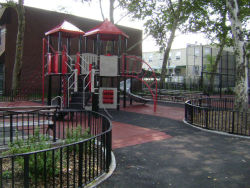Carver Playground
Carver Playground
Carver Playground was named in honor of George Washington Carver (1864-1943), famed African-American educator and agricultural researcher. Born in the Missouri town of Diamond, he, his mother, and his older brother were the only slaves of the Carver family. As an infant, Carver’s mother disappeared, likely at the hands of slave raiders, and he and his brother were raised free by the Carver family. Carver had an active mind as a child and displayed an early interest in plants, a liking that foreshadowed his later mastery of agriculture and farming techniques.
Carver left Diamond at age 10 to pursue an education, and he attended a colored school in nearby Neosho. He maintained his interest in plants while working various jobs to put himself through high school in Minneapolis, Kansas, as well as during his first and only year at Simpson College in Iowa (1890). Having tired of Simpson, Carver transferred to Iowa State College where he would earn a B.S. in 1894 and an M.S. in 1896, both in the field of agriculture.
After graduation, Carver joined the staff of the Tuskegee Institute as director of the Department of Agricultural Research, a post he retained for the rest of his life. Carver’s work at Tuskegee gained him a substantial international reputation, due primarily to his efforts at bettering the economic position of African-Americans in the South. Through the introduction of innovative methods of crop rotation and soil improvement, Carver’s techniques significantly increased the crop yields of rural black farmers.
Carver is best remembered, however, for his enterprising studies of the peanut. This research bred a wealth of derivations, including knowledge that led to the improved production of cheese, milk, coffee, flour, ink, dyes, wood stains, and insulating board. This research also helped Carver resolve the problem of malnutrition in the rural South; through tours of the area, Carver was able to promote the peanut as a significant source of protein that could enrich farmers’ diets and improve their health.
Despite his extensive research, Carver only patented three of his 500 agricultural inventions, reasoning, “God gave them to me, how can I sell them to someone elseΑ” In 1916, Carver was appointed to the Royal Society of Arts in London, and in 1923 he received the National Association for the Advancement for Colored People’s (NAACP) Springarn Medal for his contributions to agriculture. Before his death in 1943, Carver contributed his life savings to a foundation for research at Tuskegee. His birthplace was designated a National Monument in 1953.
Located at Ralph Avenue between Marion and Sumpter Streets, the site of Carver Playground was vested to the City of New York on March 28, 1963 and jurisdiction was granted to Parks the same day. This playground, jointly operated by Parks and the Board of Education, opened on April 6, 1967. Originally known as P.S. 40 (George W. Carver School) Playground, Commissioner Stern officially renamed the park to honor Carver in 1985. The playground contains a slide, benches, a public restroom, and a flagpole with a yardarm bearing the flags of Parks, the City of New York, and the United States. The park received renovations, completed in 2002, with $520,000 of funds allocated by Council Member Tracy L. Boyland.
Check out your park's Vital Signs
Clean & Safe
Green & Resilient
Empowered & Engaged Users
Share your feedback or learn more about how this park is part of a
Vital Park System

